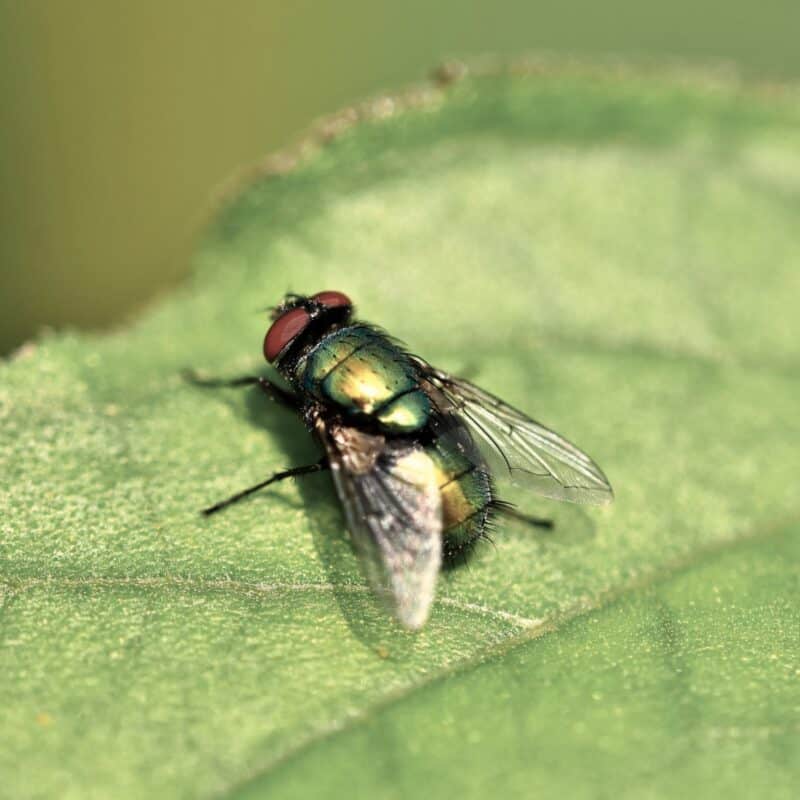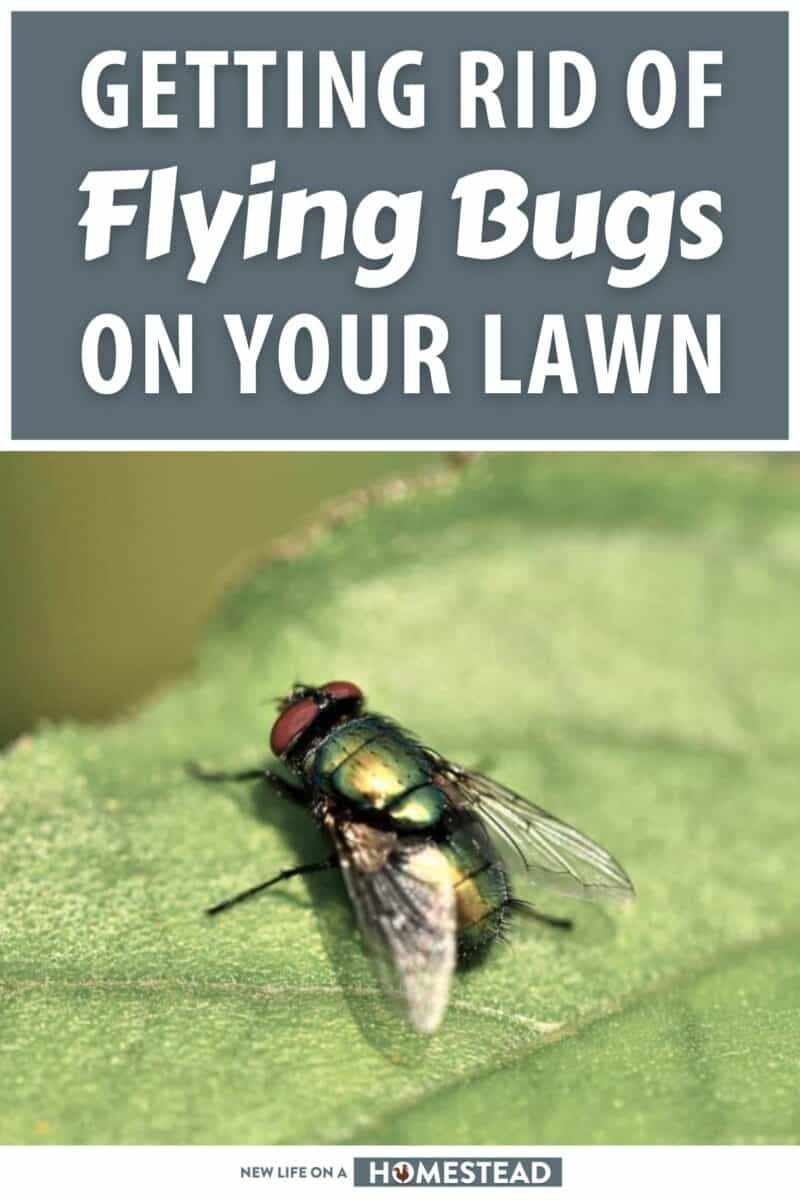Bugs can be a major source of irritation, and we typically squish or spray every bug that we can get. Unfortunately, that includes the ones that help our gardens. This leads to further issues, and possibly adds more damage to your yard.

Letting nature run its course is often the best course of action, despite how irritating it can be.
It doesn’t help that flying bugs are the hardest to deal with, if you must kill them yourself, you need to be careful to only get the intended target and this list should help you do that.
Table of Contents:
Common Pests with Wings
There are many, many pests that can damage your grass and garden, but not all of them can fly. So, let’s look at a few that can fly and how to get rid of them. First off, some of the common pests are:
- Mosquitoes – they bite and leave an irritating, itchy spot. They also carry a variety of diseases including malaria and the zika virus.
- Lawn Gnats – noisy, biting bugs that can be a genuine nuisance.
- Chinch Bugs – They feed on the sap in certain grasses and can damage your grass very quickly.
- Biting Midge – they bite, and those bites are painful!
- Flies – these are just irritating, but they can also carry some diseases.
- Fiery Skippers – As a caterpillar, these guys leave brown spots on your lawn and the eggs are laid under the grass.
- June Beetles – June beetles tunnel dry out the soil by tunneling into it.
- Bees, Hornets, and Wasps – bees, hornets, and wasps are stinging bugs and certain species of hornets and wasps will make parts of your lawn unusable by building their nests in specific spots.
- Asian Ladybugs – they have a painful bite and let off a really disgusting smell when you squish ‘em.
Prevention Methods
1. LED Bulbs
Over the past few years, we’ve seen a large reduction in the use of old-fashioned incandescent lightbulbs.
These incandescent bulbs can and do attract a number of flying pests that can wreak havoc in your garden which is why they’re being replaced by LED lightbulbs in most places. LED bulbs attract fewer pests.
2. Cover Trash
Your trash is often an attractor of flying bugs and while they may start out gorging themselves on what’s in the bags, there are some that will move on to your lawn.
How do you prevent this? Well, you keep your trash can covered. If the trash is closed, it can’t attract insects that will pose a threat to your lawn.
3. Vinegar
Vinegar is something that you can use to rid yourself of certain pests without harming your garden. You can leave a container full of it out at night and it’ll attract them. They go into the vinegar and can’t get out again.
Alternatively, you can also use beer – assuming you don’t mind sharing a keg with your lawn pests.
4. Fly Paper/sticky traps
Fly paper is a well-known solution for flies and other flying insects. Sticky traps, in general, are pretty effective; lay them out, and the bugs land on the paper/trap and get stuck. They’re stuck so they can’t cause any problems for you and your garden.
5. Flowers/plants
We all like a few pretty flowers in our gardens, don’t we? Well, some of those plants can be used to repel flying bugs and keep them away from your garden. Marigolds, for example, can be used to repel mosquitoes and basil can be used to repel bugs like wasps and hornets.
6. Pest Control Professionals
Calling a professional pest control company is usually the best course of action when dealing with a large infestation of particularly nasty flying pests – particularly bees, wasps, and hornets. Trying to get rid of a swarm on your own is not a very good idea.
While bees won’t sting you without provocation, wasps and hornets aren’t so averse to that idea. The stings are painful and can sometimes cause serious medical emergencies – anaphylactic shock is no joke.
DO NOT TRY TO REMOVE THE NEST/HIVE BY YOURSELF!
Seriously, don’t, it won’t end well. Call a professional who knows what to do and how to do it.
7. Insecticides
Pesticides are an obvious solution, but you may want to be careful here. Try to use targeted pesticides – i.e. chemicals that will affect the problem bug only and leave the good bugs alone.
Ideally, you want to use organic, environmentally friendly stuff that won’t pose a threat to your family and pets.
8. Bats
Na,na,na,na, BATMAN!
Okay, now that the bat joke is out of the way, let’s get to the serious stuff. Bats are nocturnal hunters and can eat around 8,000 bugs in one night – wow, talk about an appetite!
Now, my own experience with bats is limited to petting a few when I was a kid and trying catch them and take them outside when they get into the house, and not everyone is going to be too keen on having them around.
If they’ll eat all the mosquitoes, moths, and other irritating flyers, they’re good in my book – as long as they stay outside, of course.
9. Soapy Water
Ah, the old soapy water trick! As weird as it sounds, this trick does actually work – albeit only on certain bugs.
If you want to kill off a bug of a particular variety, spraying them with soapy water is a good way to do it.
10. Citronella
Burn a bit of citronella oil, bugs like mosquitoes can’t stand the stuff and will do everything they can to avoid it.
I keep a bottle of citronella oil open on the shelf in my bedroom and while the scent can sometimes be overwhelming, it keeps the little summertime bloodsuckers out of the room and away from me!
11. Maintenance
Maintaining your garden is another way to prevent lawn pests. Keeping your lawn and garden neat and tidy means fewer places for pests to hide and proliferate. Of course, that means you have fewer bugs to worry about.
12. Get a Zapper
This is a well-known piece of tech, it’s a light that attracts and electrocutes bugs. Unfortunately, they’re only really useful at night but they do a good job of getting rid of flying bugs.
13. Bring in the Birds!
Birds love eating bugs so if you can use bird feeders to attract birds into your yard, they’ll eat all the flying bugs they can get.
The bountiful bug banquet (try saying that five times fast) is likely to keep the birds hanging around for a good while.
14. Nematodes
These parasites can be bought online or brought in from an exterior water source, and they feed on bugs – typically in the larval stage. Large numbers of bugs mean an ample food supply.
15. Bacteria
Certain bacteria can stop the digestion of food which causes the bug to starve. If bugs are dying of starvation, the population is obviously going to decrease.
16. Parasitic Wasps
These wasps lay their eggs inside an aphid. When those eggs hatch, the larvae eat their way out of the aphid…somehow that reminds me of the chest-burster scene in Alien. These guys are real-life Xenomorphs!
17. Bark Dust
Bark dust is a sort of fungus that attacks the eggs, larvae, and pupae of mosquitos and other flying bugs. Sprinkling some of this on your lawn or in the problem area will quickly reduce the number of flying, biting bugs.
18. Diometaceous Earth
Diometaceous earth is made up of fossilized marine life and works as an insecticide of sorts by breaking down the exoskeletons of the bugs that come into contact with it.
19. Sawdust
Sawdust can be used to smother problematic insects and, since it’s made of wood, it’s environmentally friendly. It’s also very easy to buy, most nurseries, and online places stock sawdust.
20. Garlic
Yes, garlic can be used to repel and kill bugs. How? Well, that’s simple; there are chemicals in garlic that attack the cells of the bug’s body. Kind of hard to cause trouble when your cellular structure is being destroyed, isn’t it?
There are Many More Options Out There
These are just a few options that you have available that work. There are many other methods that you can use.
With that said, I’m curious; have you had flying bugs messing around with your lawn? If so, what were they and how’d you deal with them?
I hope you found this article informative and that it helps you out in some small way. Thanks for reading and I’ll see you for the next one. Take care!


Greg is a South African farmer and homesteader who’s been around animals ever since he can remember. He’s also an avid camper and hiker.
